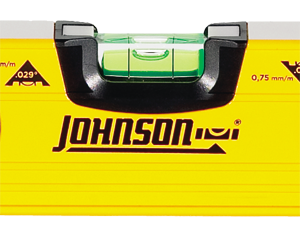Spirit Level Information
There are many manufactures of spirit levels including Johnson Level, Empire Level, Stabila and Stanley or Stanley/Bostitch, to name the most well known brands. But despite the different makers, a spirit levels use and features are roughly the same. A Spirit Level is a tool used to indicate how parallel (level) or perpendicular (plumb) a surface is relative to the earth. A spirit level gets its name from the mineral spirit solution inside the levels. Typically, the vials in a spirit level are a yellowish-green color with additives for UV protection and maximum performance in temperatures ranging from -20 degrees F to 130 degrees F. The best spirit level is accurate to within plus or minus 0.5 millimeters/meter, or 0.005 inches/inch or .029 degrees. The next level of accuracy displayed is 0.75mm/m or.043 degrees. The vial bodies of a spirit level, also referred to as a bubble level, can be shaped like a barrel, like a rectangular block or even curved, banana-shaped, to measure slope in fractions per foot of pitch; and are mostly made from acrylic today versus glass originally.
 Spirit levels are made from a variety of materials including aluminum, plastic, wood, cast iron and composite materials. Users of spirit levels are categorized as professional contractors and tradesman, such as carpenters, masons, framers, electricians, plumbers and woodworkers; and do-it-yourselfers, such as a homeowner.
Spirit levels are made from a variety of materials including aluminum, plastic, wood, cast iron and composite materials. Users of spirit levels are categorized as professional contractors and tradesman, such as carpenters, masons, framers, electricians, plumbers and woodworkers; and do-it-yourselfers, such as a homeowner.
There are a variety of spirit level styles for tradesman and contractors to chose from, the most popular being i-beam levels (the level frame is an "i" shape when looking at its end), box beam levels (the level frame is a rectangle shape) and torpedo levels (slightly bigger than pocket-sized, 9" to 12" 3-vial levels). Other spirit level styles include: line levels (single vial with a hook to hand on a string), cross check levels (pocket size; two level vials at right angles), circular levels (surface levels), pocket levels (pen shaped with a magnetic tip) and post levels (wraps around two sides of a post to measure level and plumb).
There are other functional spirit level features beyond style and material such as magnetism, vial type and durability. Some spirit levels are magnetic which are ideal for construction with metal studs, or a plumber or electrician working around pipes and conduit. Magnet strength versus a spirit levels weight is an important test for quality; rare earth magnets are the strongest. Some spirit levels have replaceable vials, such as i-beam levels with barrel shaped vials which are set into the frame, or wood levels with banana-shaped vials. Block vials on box beam levels are machine set and cannot be replaced with the same accuracy as provided by the factory. Spirit levels are also made more durable with the inclusion of vial covers to protect the vial and end-caps to withstand the shock of being dropped. Some spirit levels have hand grips, which are primarily for comfort.
Quality spirit levels are manufactured by a select group of companies. Manufacturing in the United States is dominated by Johnson Level & Tool and Empire Level (both in Wisconsin). Johnson spirit levels are the hi-visibility green/yellow color while Empire advertises blue vials on their best levels. Smaller U.S. manufacturers of spirit levels include Maye's (owned by Great Neck Saw) and wood spirit level manufacturers Crick and Smith. In Europe, primary spirit level manufacturers include Stabila (Germany) and Kapro (Israel). In Asia, there are only a handful of quality manufacturers of spirit levels. Stanley/Bostitch levels are manufactured in Thailand and East Precision is the largest manufacturer in China, supplying spirit levels under private brands in both Western and Eastern Europe. Other well known brands have spirit levels but do not manufacture them. Swanson spirit levels, found primarily at Lowe's stores, are manufactured through Chinese sourcing and recently DeWalt entered the level category with a top-end box beam level manufactured by Empire Level.
The history of levels trace the first levels to ancient Egypt; along with references to levels in Masonic texts. Wikipedia highlights the history of the spirit level as being invented by French scientist and mathematician, Melchisedech Thevenot, in the mid 17th century with some arguing spirit levels did not come into practice until the next century. Regardless, Henry Ziemann, who founded Empire Level, is correctly credited with inventing the mono vial, or single level vial system, for use in a spirit level.
For more information on spirit levels, visit Wikipedia's Spirit Levelor Engineer's Spirit Level article.
To see examples of a variety of spirit levels, see Johnson Level's variety of box beam levels, i-beam levels and wood levels.
©2010 Johnson Level & Tool Mfg. Co., Inc.